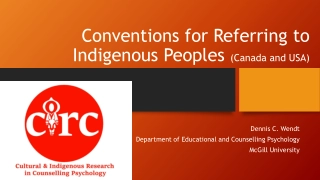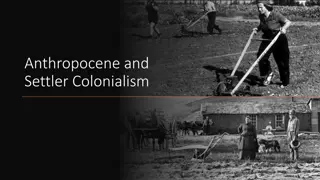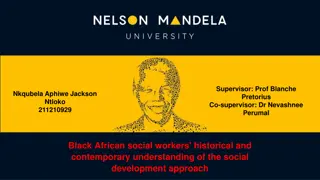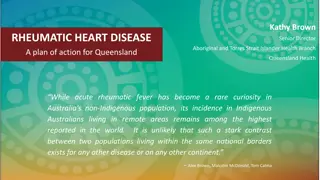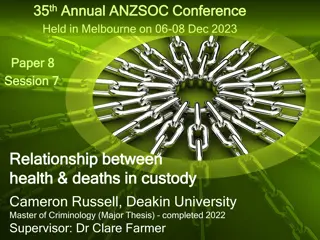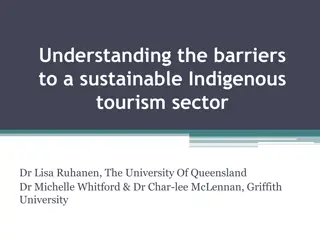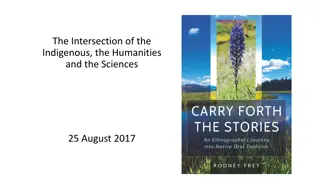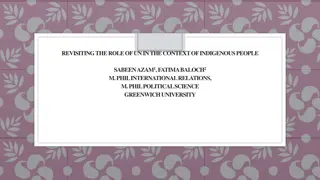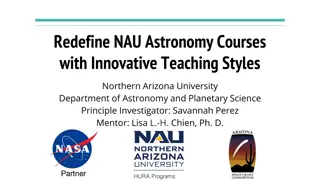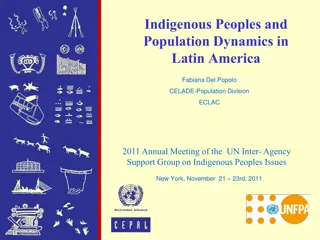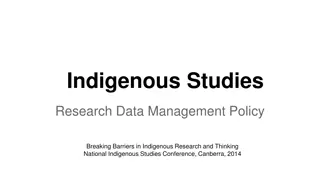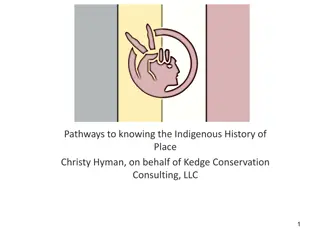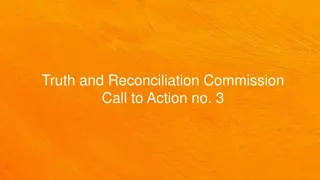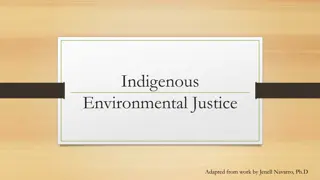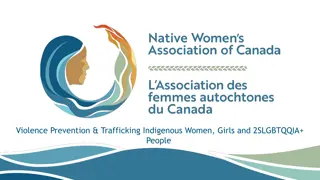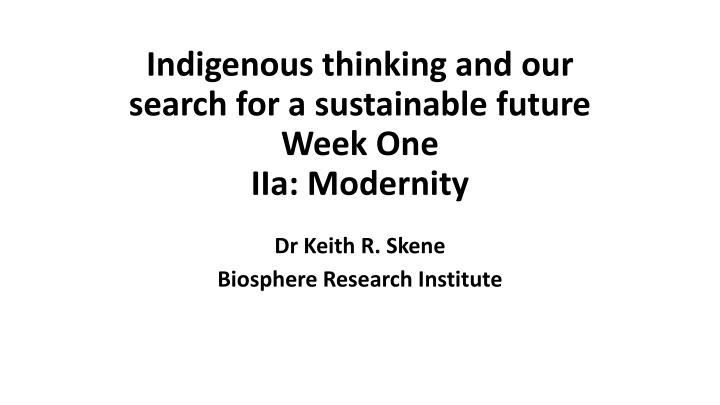
Indigenous Thinking and the Search for a Sustainable Future
Delve into the profound connection between Indigenous thinking and sustainability, exploring the breakdown of humanity's relationship with the Earth system due to modernity. Follow the journey from agricultural surplus to organized religion's clash with animism, reflecting on the implications for our future.
Download Presentation

Please find below an Image/Link to download the presentation.
The content on the website is provided AS IS for your information and personal use only. It may not be sold, licensed, or shared on other websites without obtaining consent from the author. If you encounter any issues during the download, it is possible that the publisher has removed the file from their server.
You are allowed to download the files provided on this website for personal or commercial use, subject to the condition that they are used lawfully. All files are the property of their respective owners.
The content on the website is provided AS IS for your information and personal use only. It may not be sold, licensed, or shared on other websites without obtaining consent from the author.
E N D
Presentation Transcript
Indigenous thinking and our search for a sustainable future Week One IIa: Modernity Dr Keith R. Skene Biosphere Research Institute
Breaking the Bond Between Nature and Humanity: Out of Eden
Humans have lived in an interconnected relationship with the Earth system for some 95% of our time on the planet Only during the Holocene has this relationship increasingly broken down, with the advent of agriculture, irrigation, the built environment, trade, empiricism and land ownership The loss of connectivity and ecological intelligence has been the distinguishing outcome.
The Parting of the Ways Agricultural surplus - Food as a given rather than a key driver Trade (economics) -monetization, power, commoditization (of nature and humanity) and inequality Hunter-gatherer to settler - urbanization Specialization and division of labour - not all about food: military, builders, planners, extractors, exploiters, exploited
Organized religion and the fight against animism Whitby Synod settled date of Easter and hair cuts End of Celtic Christianity with its emphasis on nature as an extension of God (still held by Orthodox Church) Continued antagonism towards animistic beliefs into Victorian era.
King Oswiu and his fasting wife Oswiu followed Celtic Christianity Celtic Easter could fall up to a month after Roman Easter The King s wife followed Roman Easter and would still be fasting While Oswiu feasted Something had to be done.
Whitby Synod was organized Two sides presented arguments Oswiu ruled that Rome had it right Rome took primacy over all Northumberland, including Lindisfarne Episcopal seat was moved to York from Lindisfarne Beginning of the end for Celtic traditions
Shift in Philosophy Feminist writers discuss the advent of the Enlightenment and the Scientific Revolution as instigating a qualitative shift in the natural philosophy of Western societies Each new development (or progression ) in thought seemed to sever our connectivity more and more, replacing it with a growing sense of human privilege, ascendancy and dominance over Nature and other human beings (e.g. Merchant 1980).
Dualism: the parting of the ways Western views of Nature celebrated a dualism between human and nature Nature as an object of exploitation, Nature as an object of investigation (e.g. seeing a given natural item as only an experimental unit), and Nature as an object of ownership. Indigenous people were classed as part of Nature.
Marquis of Condorcet Nature has placed no limits on our hopes
John Locke In 1689, John Locke argued that, initially, God created the world and gave it to men in common to use for their sustenance in the state of nature. In other words, all the world was a commons. Locke stated that [L]abour, in the beginning, gave a right of property (Locke orig. 1689, para. 45). Thus, agricultural efforts would legitimize ownership, provided that it did not disadvantage others Indigenous people were not counted as others .
Terra nullius Fundamental to Locke s position was the belief that indigenous people were part of nature, being neither civilized nor rational, and therefore they had no claim to the commons Land occupied by indigenous tribes was declared terra nullius, or empty land See additional material on website.
Darwin, when he observed the native human inhabitants of Tierra del Fuego, was disgusted: Viewing such men , he confided to his journal, one can hardly make oneself believe that they are fellow creatures and inhabitants of the same world (Darwin 1860: 216).
Primitivism Theories of environmental determinism sought to explain indigenous populations primitivism A consequence of environmental constraints and racial deficits This informed colonial policies that sought to exclude or marginalize indigenous and other non-white (non-indigenous) populations. Luigi Persico, Discovery of America, 1844
Detribalization and forced labour Nature was raw in tooth and claw , and was there to be subjugated, much like the indigenous people Not only could native lands be taken, but the people living there could be tamed and forced into productivity.
Mabo v Queensland It would not be until 1992 that the concept of terra nullius would be overturned in law In the case Mabo v Queensland (1992) 66 ALJR 408 The court held that the lands were not terra nullius or practically unoccupied in 1788, when the British claimed ownership of aboriginal lands in Australia.
Who was Eddie Mabo? Torres Straits Islander As a radical fighter for land rights he was banned from returning to his home island A test case, seeking to overturn Terra Nullius, was formulated in 1991 On 3rd June, 1992, the High Court overturned the terra nullius doctrine Sadly, Mabo had died of cancer, aged 55 on 21 January 1992 He was buried as a king on his island, Murray Island.
Noble savage or sub-human During the period of colonisation indigenous peoples were constructed in two main forms: Innocent and pure, but requiring salvation, education and protection or barbaric, untamable beasts, requiring extermination or forcible subjugation This portrait of noble savage or subhuman beast formed a dichotomous reduction which was often held simultaneously.
Evolution and ecology: dualism within Nature Darwinian theory: Nature raw in tooth and claw Ecology: Cohesive, interactive entity (See Skene, 2017).
Colonial actions In mid-19th century Norway, Saami children were punished for speaking Saami, and their teachers were paid extra to monitor the parents language use The period between 1870 to 1970 is called the dark century in Norwegian policy towards Saami peoples a harsh assimilation phase that had detrimental effects.
Canada and USA Colonial education was explicitly assimilationist from the 17th throughout most of the 20th century In both nations, Native children were forcibly taken from their families to residential schools far from their homes And were severely punished for Indian talk
Britain in Australia Australia s British colonial government applied tactics of isolation and assimilation with a White Australia policy Intended to breed out [Aboriginal peoples ] black traits in order to produce a homogeneous English-speaking Anglo-Saxon culture
Latin America In Latin America, a clear intention of eradicating Indigenous ethnocultural differences underlay centuries of policies designed to configure a uniform national society through segregated subtractive schooling.
Enclosure Enlightenment philosophies of private property, the ascendancy of science and the dehumanization of unenlightened, non-Western subjects justified the enclosure and domination of indigenous places and any meaningful connection with the land.
Land was seen as merely the spatio-temporal location of human affairs, arbitrary except for what natural resources it proffered Indigenous communities were uprooted and relocated into undeveloped land-bases which were deemed suitable by Western courts.
Trail of Tears and Death 1830 Indian Removal Act: President Jackson Theft of 1.5 billion acres Thousands died
This severed ancestral connectivity to the original landscape from which emerged their language, customs, culture and ways of life. Being in this new land was experienced as extreme disconnection Furthermore, this disconnection was compounded by surveillance of their traditional practices.
Conservation strategies and rewilding Modern (Western) conservation approaches often attempt to separate culture from nature, protecting nature from humans.
Criminalization of indigenous practices By removing the indigenous populations from their land, this led to criminalization of normal activities such as hunting, farming and the use of fire turning hunters into poachers and trespassers.
San Bushmen Botswana shoot on sight policy on poachers San bushmen (oldest tribe on Earth) rely on hunting to feed families Tribal groups such as the Ogiek and Sengwer, the San, Maasai and Baka are being forced out of forests and wildlife-rich plains in Africa to protect nature American Indians cleared from forests Resulted in hugely damaging fires.
Conservation v People Most of the world s 6,000 national parks and 100,000 protected places have been created by the removal of tribal peoples Simon Counsell, director of the UK s Rainforest Foundation, agrees: Much conservation is still in the mindset of being in opposition to people. The conservation v people approach to protecting wildlife has worsened the lives of thousands of native people.
Shona In Zimbabwe, the colonial government viewed the Shona production methods as inefficient and damaging to the landscape, meaning that these traditional practices, which had emerged and evolved in these landscapes over thousands of years, were now criminalized.
Furthermore, cultural practices and indigenous languages, central to the regeneration of traditional knowledge, were viewed as pagan, ignorant and even satanic.
Bernard Grzimek excluded the Maasai from the Serengeti plains, claiming A National Park must remain primordial wilderness to be effective. No man, not even native ones, should live inside its borders
These conservation strategies are premised on two fictions: the Garden of Eden of untroubled wilderness can only thrive in the absence of human communities and that minimal disturbance (similar to a scientific experiment) bodes the best for ecosystem health.
The planet is not a library where silence must rule Indeed, some noise is an essential ingredient for any diverse, resilient and healthy ecosystem; it is a matter of how much noise Indigenous people know how much noise to make The intermediate disturbance hypothesis Sub-optimal in all things.
Danford Chibvongodze (2016) writes that The conservation of the environment in African societies rests upon a deliberate and conscious dove-tailing of cultural and social identities with the natural and wildlife environment. Central to this is the integrated, local, emergent nature of indigenous knowledge Indigenous knowledge is utilitarian and landscape-based As is culture.
By dissecting and denying indigenous practices relating to the land (hunting, fishing, building, making, celebrating) and through separation and re-education of language, the cyclical inheritance of identity, value, meaning, one s sense of context and empowerment is broken.
Donald Fixico (2003: 8) notes that the linear mind looks for cause and effect, and the Indian mind seeks to comprehend relationships .
Fire ecology and indigenous practice Karuk tribal members in California, were negatively impacted by the effects of deep- burning fires and intensive firefighting activities which resulted from their exclusion from the landscape.
Denial of indigenous knowledge It was unthinkable to imagine that indigenous knowledge could better attend to the natural disaster than the tools, technologies and manpower of the modern Western state Yet it was indigenous occupants who were capable of foreseeing what unsustainable conditions in these forests would lead to, and are best placed to understand what is best for the land and what serves its recovery See Youtube videos in website.
Fikret Berkes The irony is that, just as globalization has liberated traditional people from their local ecosystems on which they used to depend, they are receiving attention as a source of inspiration so that the industrial world does not destroy the larger global ecosystem on which all people depend.
The centrality of the Earth system The deep knowledge of ecology, systems theory, relationality and higher order cosmology Enriched with temporal and spatial dimensions through storytelling and evolving practice is fundamental to indigenous thinking Learning to read the landscape Far superior to reductionist Western philosophy Better equipped for the real world
What truly is primitive and what is progress? Contrast between utopian journey and reductionist philosophy of the West Versus deep ecological experience and practice across many millennia Cyclical versus unidirectional Emergent versus reductionist.


